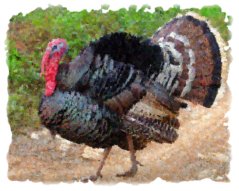
The Great American Calorie Harvest
Well, we are rocketing into the month of November, and America's official day of turkey consumption will soon be here. I don't mean to offend you folks, but you must admit that the human race does some pretty weird things at this time of year. When God created your species, you didn't have bad hearts, cancer wasn't prevalent, you weren't grossly overweight, you didn't have ulcers, and, all in all, you were pretty well set up for long-term survival. Now, here you are, just a few million years down the long path of human evolution, and your outlook is looking a little worse instead of better. Could it be your dietary habits? How does turkey enter into this discussion.
Here It is fall again, and you will soon be entering a long and calorie-laden holiday season. Starting with Columbus Day and Halloween in the month of October, and moving forward into Thanksgiving in November, you will then glide blissfully into your Christmas holiday in December. This might just be considered the Great American Quarterly Feast. The only holiday in this lineup that doesn't involve a plethora of calories - is Columbus Day. But, guess what! Columbus just might have unwittingly started it all.
It seems that many of your holidays are all about food. A few months ago when Isabel launched into her Weight Watcher's diet, we were caught flat-footed, and we had hardly a clue as to how she had obtained her extra padding. But, if you look at your national holiday traditions, her situation gains much more clarity. On Halloween, the younger segment (and their adult-parent collateral nibblers) of the American population celebrated a holiday eating candy. Less than one month later, on Thanksgiving, you will consume a virtual cornucopia of fruits, vegetables, baked goods, and, of course, the noble turkey. For Christmas you will add soothing classical religious music to the mix, pull out all the stops, and feast again on turkey, maybe a honey-baked ham, squash, potatoes, nuts, pies, cakes, candies, hot buttered rum, and any other assorted delight that is sold at your nearby food store. To top it all off, seven days later, on New Year's Eve, you just might be tempted to wash it all down with champagne or punch spiked with grain alcohol, and start the new year all over again with a clean palate along with good intentions.
In the meantime, your local Weight Watcher's and Health Clubs will be ramping up for the predictable influx of new members swarming to their doorsteps during the first week of January. By July, their membership rolls will again slump as you leave the security of their facilities to repeat the warm and wonderful days of summer.
Enough of the canine sarcasm; let's get back to Thanksgiving and the 'noble turkey.' Far be it for me to spoil your symbolic day of thanks and appreciation for the friendship extended by your new-found native American friends. That's another story for another day. I personally enjoy handouts of turkey, stuffing, and all the trimmings just as much, or more than you do; so, don't take what I say here as a negative viewpoint. Just write it off as a casual, but cynical canine observation.
October is certainly not a good month to be a turkey. In fact, in America, no month is a good month to be a turkey. Early October marks the beginning of the great roundup and slaughter of these huge, clumsy, inept birds. I guess things could be worse; as a fellow American (of Labradorian descent), I am grateful that Americans haven't developed a taste for bald eagles.
Did you realize that nearly 61% of the 185 million turkeys raised and eaten in the United States are eaten over the Thanksgiving and Christmas holidays? That's about 113 million turkeys, folks! This year (1985), the average American will consume 11.9 pounds of turkey or turkey-based products, and that number doesn't include chickens or game birds. That's a total of 5.5 billion pounds of turkey!
Did you ever wonder where turkeys originally came from, and where they got their name? I'm sure that the human species hasn't beaten itself up trying to find this answer, but you might be very surprised when you learn it. Micah Davenport, our inveterate historian, decided to invest some time at the Fannin County library, and he came up with some interesting facts. These facts serve to dissolve some of the popular myths relating to this bird.
After Christopher Columbus visited North America in 1492, he returned to his homeland with corn, tobacco, and wild turkeyss in an attempt to lure investors into funding further exploration of the New World, and this led to Spain's export of some of these birds to the Ottoman Empire (Turkey). Turkish breeders and agriculturists saw a bright furture in these oddities from the New World and worked diligently to domesticate and improve the species. They were very successful in doing so.
Mrs. Shirley Center, two time guest at Faded Glory, researched the origin of the turkey last year - and explains the return of the much improved species to America several decades later:
"In the span of twenty years, the Turkish farmers had a surplus of these birds, and began exporting them to England, along with corn and tobacco. By 1577, these fowl from Turkey had become the principal food bird in the English realm. Linked to its domestication in the Middle East, corn arrived in England as Turkish maize, tobacco was called Turkish tobacco, and our bird huexoloti was then and since known in English simply as the 'turkey.'
When the English scientist Thomas Harriot came to America in 1586 to catalog the plants and animals of Roanoke, Virginia, he carefully recorded the Algonquin names for most things, but for the native American bird that resembled the Turkish turkey, he listed the name turkie.
Since these wild American birds were ravenous scavenging birds that ate nuts, seeds, berries, insects, and delicate shoots from cultivated crops, which aggravated farmers, they were killed everywhere by the colonists as pests.
English settlers in Virginia and Massachusetts, being accustomed to the milder-mannered, domesticated birds that came from Turkey, began to import and raise them. They soon discovered that the turkeys from Turkey were no threat to the tobacco crops they raised; in fact, they ate the hornworms that destroyed tobacco plants without harming the plants. So it was these birds that had been domesticated in Turkey and brought back to America, rather than the original wild birds, that ultimately became the star of the Thanksgiving feast."
You folks are blessed all year long with the gift of speech, the gift of higher intelligence, unquestioned personal freedom and sovereignty, a God that loves you, close family relationships, and so many other things; and what will you do on your big day? You will take a day off from work, gather your family, say a short prayer, find a big fat tender turkey, and eat until you have trouble pushing yourselves away from your dining tables.
Yes, we are very fortunate here in America, and you can thank the likes of Christopher Columbus and the nameless and diligent agriculturists and poultry farmers of the Ottoman Empire for your upcoming gastronomical good fortune. Bon appetite!



